Why Do We Need Storage and Handling Facilities?
Most cases of groundwater contamination by agricultural chemicals have been caused by improper storage or mixing and loading chemicals. For this reason agricultural chemical storage and handling practices have been targeted by federal and state legislation across the United States. To satisfy the proposed regulations, dealers and applicators are encouraged to construct safe chemical storage and mixing/loading facilities with secondary containment.
The purpose of secondary containment is to contain, recover and reuse spills and rinsate. It is a form of insurance, providing environmental safety by preventing spills from entering the soil, surface water and groundwater. Secondary containment also reduces legal liability of the owner and associated costs of cleaning up a contaminated site. A well-managed and designed facility reduces worker and public exposure to agricultural chemicals.
Groundwater contamination and worker exposure can occur by: 1) unsafe storage practices, 2) large accidental spills, 3) periodic unrecovered spillage of small amounts of pesticides when mixing and loading in one location, 4) inadequate cleaning of spray equipment, 5) leaking equipment parked on site, 6) improper disposal of excess spray solutions or rinsates and 7) improper disposal of containers and other "waste" materials.
Secondary Containment
Secondary containment should be used both in the chemical storage area and the mixing/loading areas to contain liquid product spills. It prevents spills from entering into storm drains, surface water and/or leaching through the soil. This prevents groundwater contamination, which may affect human health and the environment.
Several alternatives are available for secondary containment. Evaluate the characteristics, benefits, limits, performance and management aspects of each alternative. Talk to consultants, engineers and manufacturers for detailed plans and specifications for the selected alternative. Secondary containment systems must conform to local, state and federal regulations. Containment walls or curbs are used to contain the spilled or leaking product. See Appendix I for different types of secondary containment.
Facility Planning
When planning to build or retrofit a pesticide handling and storage facility consider security , present and future storage and mixing/loading operations. Take into account personnel and environmental safety and state and federal regulations as you design facilities. The arrangement of mixing/loading pads and storage can improve efficiency while reducing personnel and environmental safety risks. Rectangular pads can be arranged to include a storage building and a mixing/loading area (Figure 1).
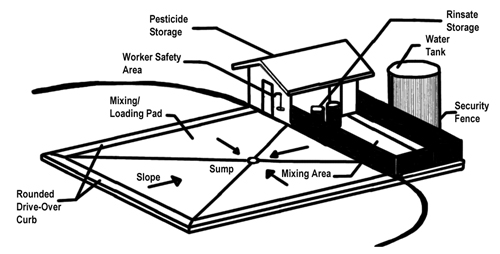 Figure 1. Drive-Across Pesticide Handling Facility.
Figure 1. Drive-Across Pesticide Handling Facility.Pesticide and rinsate storage tanks can be placed in a fenced off section across one end of the elongated pad.
Chemical storage buildings and mixing/loading pads should be located at least 100 feet from any well. The same buffer zone should be maintained between the facility and any surface water such as ditches, ponds or streams.
Pesticide Storage
Nearly three-fourths of all pesticide accidents occur to non-users of the materials. Each year there are several cases of children, livestock and pet poisonings from accidental contacts with improperly stored pesticides. These accidents cause human suffering and economic losses; improper storage is illegal. The pesticide label states proper storage environment for each product to be stored. Read the Label: It Is the Law.
Safety Considerations
Lock pesticides and related materials in a cabinet, room or separate building designated solely to store these materials. Metal storage cabinets, such as discarded school lockers, provide excellent storage for homeowners or other users of small amounts of pesticides.
When feasible, the storage area should be downwind and downhill from sensitive areas, such as homes, play areas, feedlots, animal shelters, gardens and groundwater sources. The area should be located in an area not subject to flooding.
The chemical storage area must be posted with signs at least 50 feet from and around the entrance stating "DANGER: PESTICIDES," "KEEP OUT," "NO SMOKING AREA" or similar signs. Access to this facility must be limited to only one, two or three individuals. Never store pesticides where food, feed, seed, fertilizers or other products can become contaminated. Store dry pesticides on the top shelves and liquids on the lower shelves. Always store chemicals in the original, labeled container. Make sure they're tightly sealed.
Maintain a current inventory of all materials in storage, along with a label of all materials, in a secure area away from the storage area. Date and identify all pesticides when they are placed into storage, and store no more than will be needed for one season. Establish a policy of first-in, first-used, so that pesticides do not become outdated. Provide the local fire department with an updated copy of this inventory .
Equip the storage area with personal protective equipment and materials to prevent accidents and to handle accidents and spills. Activated charcoal, absorptive clay, venniculite, clay-granule type cat litter or sawdust are good materials to absorb liquid spills.
Design Considerations
Concrete is a popular material for construction of secondary containment floors and walls. It is easy to clean and does not easily absorb chemicals. The floor must be designed to withstand the loads from the equipment and containers. Watertight design specifications and low permeability allow concrete to be easily cleaned and decontaminated.
A 4- to 6-inch high concrete retaining wall around the perimeter is needed to contain spills. Proper jointing practices and use of steel reinforcement can control and reduce the amount of concrete cracking. The wall-to-floor joint must be watertight and may contain a flexible water stop (Figure 2). If cracks appear, use flexible, chemically resistant sealants to seal cracks. Consult engineers and contractors for proper design information. Appendix II lists design specifications for facilities.
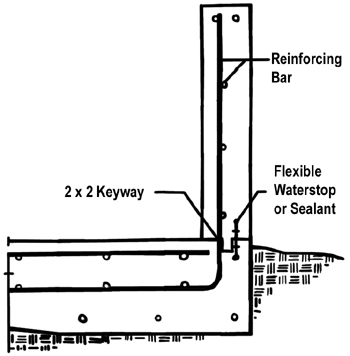 Figure 2. Wall to Floor Connection with Waterstop.
Figure 2. Wall to Floor Connection with Waterstop.The facility should be reasonably fireproof and well-ventilated. Ventilation rates should be enough to remove chemical vapors. For natural ventilation, provide a minimum of two 8-inch by 8-inch vents located on opposite sides of the storage room and 12 inches above the floor. Mechanical ventilation should be a minimum of 150 CFM For larger buildings (greater than 1,000 ft3) design for six air exchanges per hour. When the area is unoccupied, use one air exchange per hour as a design criteria.
Temperatures should be kept between freezing and 100 degrees F. Provide heat by hot water or electric heaters that are UL listed for Class I hazardous locations. Never use or allow open flames in storage or handling areas. Electrical fixtures should be dust and explosion proof.
Sealed concrete floors, concrete block wall and metal shelves are recommended over wooden structures.
Provide adequate space to securely store empty pesticide containers until you can properly dispose of them.
Include a drainage system containing a sump to collect spills. Treat this material as surplus pesticide and dispose of it properly, according to label instructions.
Locate storage buildings on a well drained site. An example of a small storage building is shown in Figure 3.
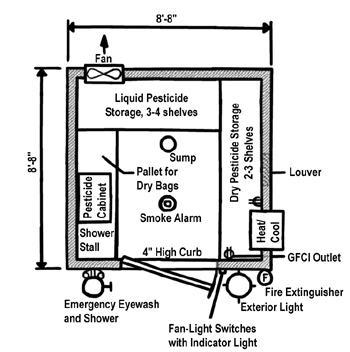 Figure 3. Plan View of Small Pesticide Storage Building.
Figure 3. Plan View of Small Pesticide Storage Building.Pesticide Mixing and Loading
Field Loading of Agricultural Chemicals
Field loading of chemicals moves the handling site farther from the farmstead and potentially from the well. Use a nurse tank to supply water to fill the sprayer and add chemicals at the field location. Field loading of chemicals will be exempt from secondary containment if you vary the location of the mixing/ loading site. The law requires you to report and clean up spills. The liability associated with and the cost of clean-up falls to the person or firm responsible for the spill.
When finishing a field, mix only the amount required to finish spraying the field. Clean the tank by adding water, at least 10 percent of tank volume, to remove chemical residue. This creates a 2 to 3 percent labeled solution. Then you can spray this material back over the field. Wash the exterior at the same time, but avoid repeated washing in the same location; stay clear of wells, surface water bodies and field drains. This will allow for the residue to be left in the field of pesticide destination. Moving the site each time the sprayer is filled will prevent chronic spills from saturating the site.
Temporary/Transportable Synthetic Facilities
Several manufacturers market portable, flexible or inflatable walled, synthetic, drive-over mixing/loading pads that fold up for transport. These units are used at remote or satellite operations for temporary field mixing/ loading to catch drips and spills. They are not used for permanent mixing/loading facilities. A small sump pump can recover diluted pesticide spills and rinsate. There may be more development and use of portable mixing/ loading systems as applicators try to reduce the risk of field spills.
Mixing/Loading Facility
A mixing/loading facility will be required if chemicals are mixed and loaded at one location. Mixing/ loading pads consist of a pad containing a sump and a set of tanks to hold water containing pesticide solution.
When a spill occurs, recover all liquids. The secondary containment sump provides a place for leaks, spills or rainfall to accumulate. A pump removes the accumulated liquids into the set of rinsate tanks. Rinsate tanks temporarily hold diluted pesticide field mixture rinsate (typically 10:1 dilution ratio from field mixtures). Rinse pesticide spray tanks and plumbing that contain 4-10 gallons of field- strength pesticides with 50-80 gallons of water. This rinsate can be used later as 20 percent of makeup water. Rinsate at 5-10 percent of field strength adds only 1-2 percent to total active ingredients to new mixtures. When switching crops and pesticides, double or triple rinse and use detergents and/or ammonia solutions to minimize pesticide residual in the plumbing, similar to triple rinsing pesticide containers. Each time you empty a tank, flush it immediately and thoroughly to prevent pesticides from drying on tank walls and to wash bottom sediment out. Flush hoses and piping after each use to minimize cross-contamination. Transfer the water used for flushing to the sprayer tank as makeup water along with the field mix rinsate. Follow this procedure as a management practice throughout the spraying season.
The secondary containment volume needed in the pad area will depend on the size of rinsate tanks or sprayer tank size. It should be able to hold 110 to 125 percent of the volume of the largest tank within the containment area. This could either be a sprayer tank or a rinsate tank. This allows for a margin of safety.
Mixing/loading pad sizes and shapes depend on the functions performed, and the orientation and boom width of the equipment. As a general rule, pads should extend at least 5 feet on each side of the edges of the spray equipment's extended boom to catch any splashed water
or boom sprays. You may need extra space for workers to easily move around or in between pieces of equipment.
A simple concrete pad that drains to a single sump in the center of the pad (Figure 4) may meet the containment needs. Pads can incorporate a small pesticide storage building on or adjacent to them. When connected as an extension to the pad with its own containment, these buildings provide needed storage without increasing the pad size (Figure 5). Appendix III shows additional mixing and loading pad plans.
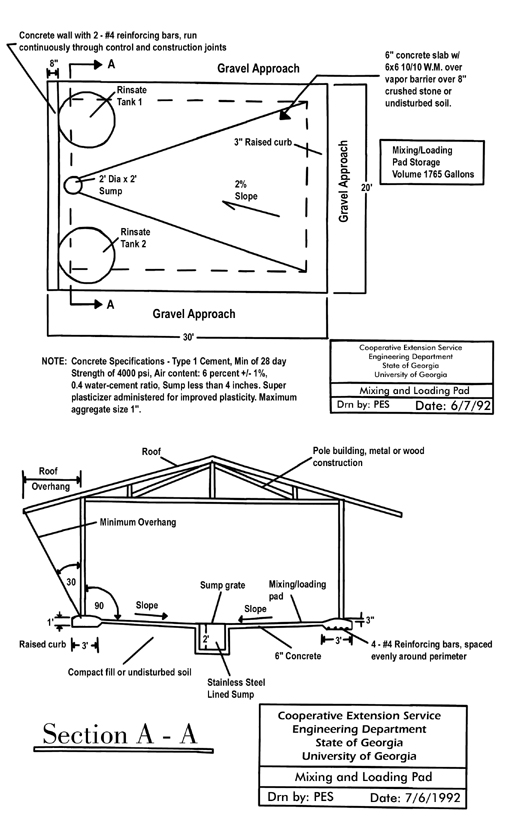 Figure 4. Simple Concrete Mixing/Loading Pad with Sump.
Figure 4. Simple Concrete Mixing/Loading Pad with Sump.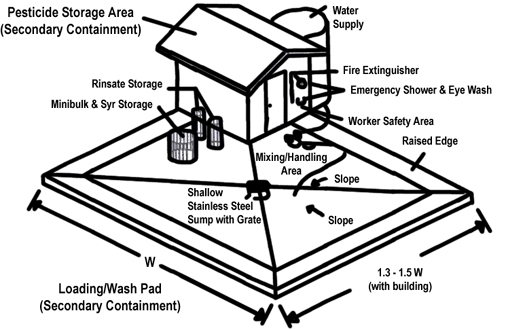 Figure 5. Simple Single Pump Concrete Pesticide Storage/Loading Facility for Small Operators.
Figure 5. Simple Single Pump Concrete Pesticide Storage/Loading Facility for Small Operators.
Use sealed, liquid-tight, reinforced concrete to form an impervious barrier between the pesticide handling area and the surrounding earth. A mixing/loading pad must be able to support the weight of spraying equipment. Six inches of concrete with reinforcement steel at 12-inch centers in both directions is usually sufficient. Slope (at least 2 percent) mixing/loading pads to drain liquids to sumps.
Sumps should be located near the rinsate storage tanks; they should be a minimum size of 2 feet in diameter and 2 feet deep. Cover them with steel grating strong enough to support spraying equipment. The pad can be trimmed by a 3-inch drive-over curb. This increases containment volume. Use approach ramps to minimize dirt and trash accumulation on pad (especially important for aircraft taxiing). NOTE: Washing sprayers in the field is recommended, but avoid repeated washing in the same location and stay clear of wells, surface water bodies and field tiles and inlets.
Precipitation is a major concern when using open concrete mixing/loading pads. A 1-inch rain on a 20-foot by 30-foot concrete pad results in about 370 gallons of water. This precipitation might be considered a hazardous waste product and may create future legal problems.
Roofed mixing/loading facilities can minimize disposal of large volumes of contaminated precipitation. Use large roof overhangs of at least a 30-degree angle from vertical from the edge of the mixing/loading pad(s) in all directions (Figure 4) to minimize precipitation blow-in.
Equip the mixing/loading pad with tanks to hold rinsate. Separate storage tanks for each chemical applied. Select cross-linked polyethylene or fiberglass tanks of 300- to 600-gallon volumes. All rinsate storage tanks must be mounted 3-5 inches above the concrete floor for location of tank leaks. Use fiberglass, stainless, glass-lined or epoxy-lined tanks for liquid fertilizer.
The water supply used for mixing/loading, tank rinsing and clean-up should be equipped with anti-siphon devices. Include showers and clean-up area for the people who mix, load and apply the pesticides.
Fire detectors and fire fighting equipment should be available. A telephone should be convenient, with all emergency numbers posted.
Sumps
Several sump designs can be used in the storage and mixing/loading pad. A single sump is the simplest and can be poured simultaneously with the concrete pad. Another option is to install a pre-cast concrete or prefabricated stainless steel sump as the concrete pad is poured. To reduce sludge problems where applicator vehicles are washed, use two sumps in series. Cover the sump with a grate strong enough to support vehicle wheel loading and for safety .
A double-lined stainless steel sump design is shown in Figure 6. This design allows you to monitor potential leaks from the sump by inspecting the outer sump through the opening between inner and outer sump liners. Install a "stand pipe riser" in the inspection port of a double walled sump so that it can be inspected when liquid covers the sump grate. Lock the stand pipe riser to prevent vandalism or accidental liquid entry through the unsecured port. The sump can be constructed in different sizes or dimensions.
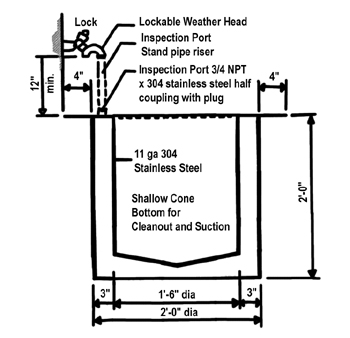 Figure 6. Stainless Steel Double Walled Sump Liner.
Figure 6. Stainless Steel Double Walled Sump Liner.Plumbing Components and Seals
Pesticide formulations often contain solvents and surfactants. Some may cause seal and gasket materials to swell, shrink, soften or dissolve over time with continuous contact. Use chemically resistant materials, such as Teflon, for seals or gaskets. NOTE: Teflon may be incompatible with some pesticides, such as Prowl and Treflan.
Hoses also should be compatible with the pesticides being handled. Hoses manufactured with an inside layer of a cross-linked high-density polyethylene material usually are chemically compatible. Mark or color-code individually dedicated hoses by the pesticide handled for transfer of rinsates into and out of each individual rinsate holding tank. Do not rigidly manifold pesticide rinsate transfer pumps directly to the inlets or outlets of rinsate storage tanks. Use detachable hoses instead of hard plumbing to isolate tanks from other plumbing. Permanent pipe manifolds may allow rinsate from one tank to accidentally mix with rinsate from other tanks in the collecting manifold. Use reinforced hoses on the suction side of the pump.
Select stainless steel or polypropylene quick-release, dry-break couplers or air-break connectors for plumbing that must be connected on a regular basis. Consider hose couplings connected to pumps, applicator vehicles, bulk tanks or mix tanks.
Use corrosion-resistant valves made from stainless steel, polypropylene or Kevlar. Minimize the number of valves to operate the system to reduce cost and potential leaks. Mount them in easy-to-reach locations for operator convenience. Use quick shutoff ball valves or plug valves. Provide lockable shutoff valves on outlets of all storage tanks for security .
Rinsate Storage Tanks
Cross-linked, high density polyethylene or fiberglass tanks of 200 to 600 gallon volumes are usually a good economical selection for rinsate storage. The ability to view liquid levels through plastic or fiberglass tank walls improves management. Inspect polyethylene tanks annually for signs of aging and deterioration to avoid a structural failure. Tanks that are under a roof and protected from direct sunlight and weather usually have a longer service life than those stored in the open.
Galvanized or standard mild steel tanks are not recommended. Type 304 or 306 stainless steel tanks are suitable, but are more expensive.
Mount storage tanks 3 to 6 inches above the concrete floor to easily locate and identify leaks. Mount the tanks high enough to allow valves and other equipment to operate fully.
Select and position (slope) tanks so that bottom outlets drain the entire tank. Permanently mount 360-degree rotating rinsing nozzles in the top of each tank for tho-rough rinsing and worker safety. Dedicate each tank to only one pesticide or one crop. Cone or hopper bottom tanks make management simpler by improving drainage of all products, including particles that settle out. Hopper bottom tank rinsing and clean-out are easier, compared to flat bottom or horizontal cylindrical tanks. Select tanks with large top access openings for ease of clean-out and inspection.
Water Supply
Prevent back-siphoning by installing back-flow devices such as check valves on the fill pipe between your water source (well) and your sprayer. Pumps don't prevent back-siphoning. A drop in voltage or water supply can cause many pumps to "cough" and allow chemicals to be siphoned down the well. Another method for filling sprayers is an elevated tank located next to the mixing and loading pad. The sprayer tank is filled by gravity flow. The water storage tank is filled by a water line.
Safety
Keep mixing/loading equipment inside a security fence. Security fences, walls, buildings or other safety measures keep unauthorized personnel, children or animals from pesticide and fertilizer storage areas. Operators are responsible for contamination and injury caused by vandals, even if a reasonable level of security is provided, but locked tank base shutoff valves and fences can help minimize legal risk and possibly reduce insurance rates.
References
Karnmel, et. al. 1991. Designing Facilities for Pesticide and Fertilizer Containment. MidWest Plan Service. Agricultural and Biosystems Engineering Department, Iowa State University , Ames, lA. MWPS-37.
Noyes, R.T. and D.W. Karnmel. 1989. Modular Concrete Wash/Containment Pad for Agricultural Chemicals. 1989 Intemational Winter ASAE Meeting, New Orleans, LA. ASAE Paper No. 891613.
Figures 1, 2, 5 and 6 reproduced with permission from: Designing Facilities for Pesticide and Fertilizer Containment, MWPS-37 1st ed. 1991. (c) Mid West Plan Service Ames, IAAA 50011-3080
Appendix I
Secondary Containment
Secondary containment should be able to hold 110 to 125 percent of the volume of the largest tank within the containment area plus the volume displaced by any other tanks in the containment. This allows for a margin of safety.
Double Tanks containment consists of placing the primary storage tank within a larger second tank. This method is common for small tanks containing less than 300 gallons of pesticides. The secondary tank should be constructed from material that is chemically compatible with the pesticide stored. The primary tank must be mounted so that it can be inspected for leaks from any location. Check used tanks carefully for structural integrity and leaks before installing them. One advantage of double tanks is that they are relatively easy to clean up.
Concrete is a popular material for construction of secondary containment floors and walls. It is easily cleaned and does not easily absorb chemicals. The walls must be designed to carry a hydrostatic load and the floor must be designed to withstand the loads from the equipment and containers. The wall-to-floor joint must be watertight and often may contain a flexible water stop (Figure 1). Watertight design specifications and low permeability allow concrete to be easily cleaned and decontaminated. Proper jointing practices and use of steel reinforcement can control and reduce the amount of concrete cracking. Flexible, chemically-resistant sealants are used to seal cracks. Consult engineers and contractors for proper design information.
Synthetic Liners are used for secondary containment of tanks ranging from 5,000 to 200,000 gallons, depending on the support structure for the liner. The support of the liner can be done in several ways. Earthen dikes can be used as the support structure. A concrete wall is another alternative to support the synthetic liner system. Types of materials that make up liners are polyethylene, polyvinyl chloride, elasticized polyolefin, chlorinated polyethylene, chlorosulfonated polyethylene, ethylene propylene diene monomer, chloroprene and extended urethane elastomer. Liners are around 20-40 mils thick depending on the manufacturer. They must be durable and chemically resistant to the stored chemical and the soil in contact with the liner.
Appendix II
Design Specifications for Chemical Containment and Mixing/Loading Pad Requirements
Concrete Design Specifications
Use watertight concrete to avoid leakage from sumps and the pad containment area. Concrete mixtures for water-tight construction to resist moisture and chemical penetration of the concrete slab surface should include the following specifications:
- Stiff dry mix for maximum strength, chemical and freeze resistance, and water tightness; water-cement ratio of 0.40-0.45 at a 1.5- to 3-inch slump;
- Type l or II cement with air entrainment (Type lA or llA) at 4000-4500 psi comprehensive strength (Type II provides moderate sulfate resistance);
- 5.5 to 7 percent air-entrainment in cement to improve work ability of the stiff mix while coating all aggregate particles for maximum water seal;
- Concrete plasticity admixture for easier work ability at placement, and improved water tightness and strength of low slump concrete;
- Vibration at 5,000 to 15,000 RPM for minimum aggregate segregation;
- Powered steel trowel surface finish for improved washing and clean-up;
- Immersion or moist cure for 14 days minimum;
- No more than 30 minutes between truck loads during placement;
- 70-100 revolutions at mixing speed; 200-300 revolutions at agitating speed.
Mixing and Loading Pad
Surface Slopes - 2 percent minimum slope to facilitate washing.
Pad Thickness - 6 inches with reinforcement steel at 12-inch centers in both directions.
Rinsate Storage - Separate storage tanks for each chemical applied. Cross-linked polyethylene or fiberglass tanks of 300 to 600 gallon volumes are a good selection. All rinsate storage tanks should be mounted 3-5 inches above the concrete floor for location of tank leaks. Fiberglass, stainless, glass- lined or epoxy-lined tanks are normally used for liquid fertilizer.
Sumps - Sumps should be located near the rinsate storage tanks and be a minimum size of 2 feet by 2 feet by 0.5 feet, or 2 feet in diameter by 0.5 feet deep. It should be covered with steel grating.
Curbing - The mixing/loading pad trimmed by a 3- inch drive over curb. This minimizes chemical spillage and increases containment volume.
Management - Sprayer systems should be rinsed with the vehicle parked on the wash pad.
Containment Volume is computed by the following equation:
| NCV = | (LTV-(GPF x CVM) x 1.25 |
| 7.5 |
Where:
NCV = Net Containment Section Volume, Cubic Feet.
LTV = Largest Tank Volume, Gallons.
GPF = Gallons Per Foot of Depth of Largest Tank
CVD = Containment Volume Depth, Feet
Containment Pad Area is computed as follows:
PA = NCV/CVD
Where:
PA = Containment Pad Area
Appendix III
Mixing/Loading Pad Volumes
| Sump located in the center of the mixing/loading pad. | |||||
| Floor Plan Number | A | B | C | D | E |
| Pad Length (feet) | 15 | 15 | 20 | 30 | 60 |
| Pad Width (feet) | 15 | 15 | 15 | 20 | 60 |
| Pad Slope (%) | 3 | 3 | 3 | 2.6 | 2 |
| Curb Width (inches) | 0 | 36 | 24 | 0 | 0 |
| Curb Height (inches) | 0 | 3 | 2 | 0 | 0 |
| Sump Diameter (feet) | 2 | 2 | 2 | 2 | 2 |
| Sump Depth (feet) | 2 | 2 | 2 | 2 | 2 |
| Sump Distance (in.) from top | 2.7 | 2.7 | 3.6 | 4.68 | 7.2 |
| Sump Volume (gallons) | 47 | 47 | 47 | 47 | 47 |
| Pad Volume (gallons) | 126 | 535 | 585 | 583 | 5386 |
| Total Pad Volume (gallons) | 173 | 582 | 632 | 630 | 5433 |
| Sump located on width side of the mixing/loading pad. | |||||
| Floor Plan Number | F | G | H | I | J |
| Pad Length (feet) | 15 | 15 | 15 | 30 | 20 |
| Pad Width (feet) | 15 | 20 | 20 | 20 | 30 |
| Pad Slope (%) | 3 | 2 | 3 | 2 | 2.5 |
| Curb Width (inches) | 0 | 0 | 24 | 36 | 0 |
| Curb Height (inches) | 0 | 0 | 2 | 3 | 0 |
| Sump Diameter (feet) | 2 | 2 | 2 | 2 | 2 |
| Sump Depth (feet) | 2 | 2 | 2 | 2 | 2 |
| Sump Distance (in.) from top | 5.4 | 3.6 | 5.2 | 7.02 | 6 |
| Sump Volume (gallons) | 47 | 47 | 47 | 47 | 47 |
| Pad Volume (gallons) | 243 | 232 | 670 | 1720 | 791 |
| Total Pad Volume (gallons) | 290 | 279 | 717 | 1767 | 838 |
Additional Mixing and Loading Pad Plans










Status and Revision History
Published on Apr 01, 2002
Published on Feb 20, 2009
Published on May 14, 2009
Published with Full Review on Feb 17, 2012


























































